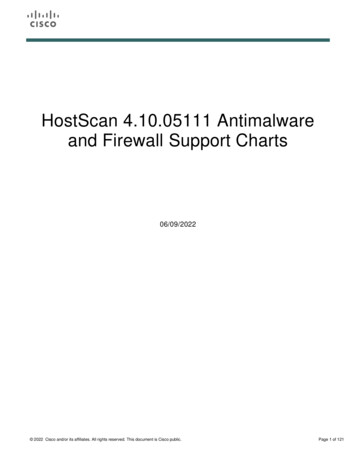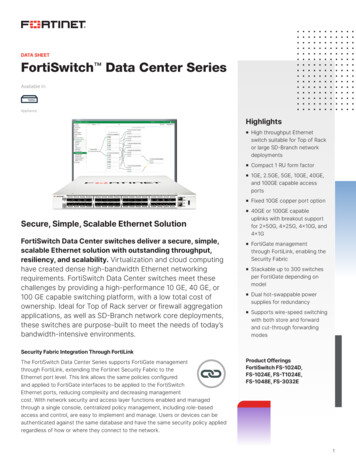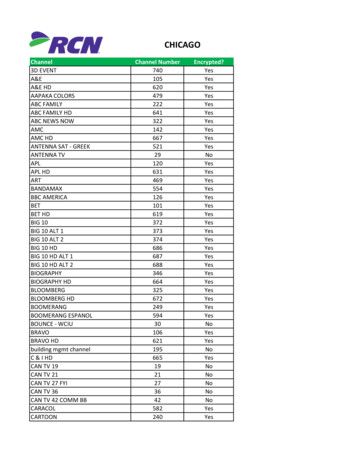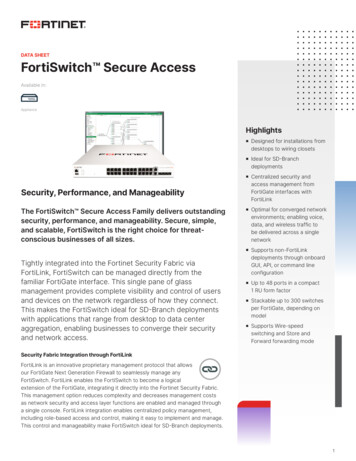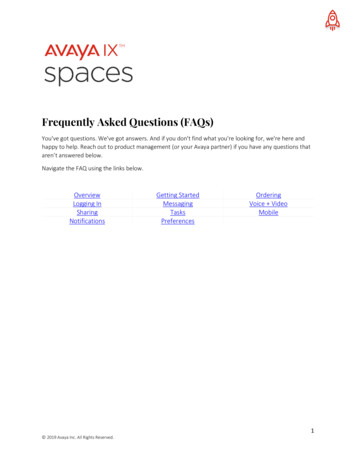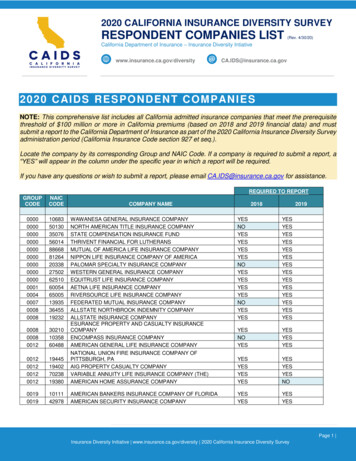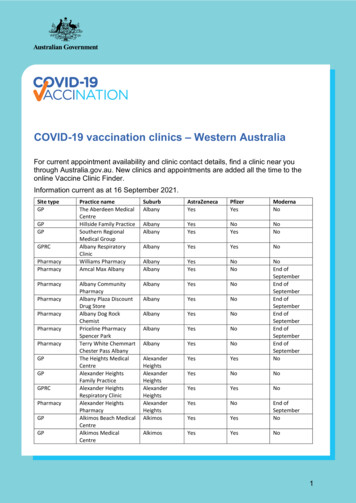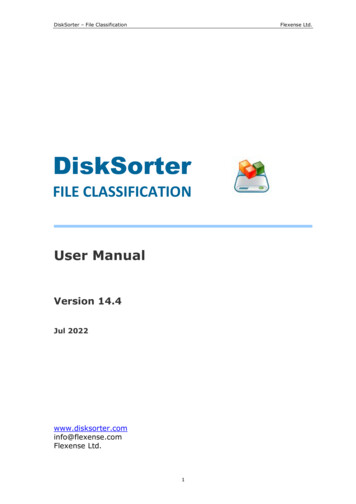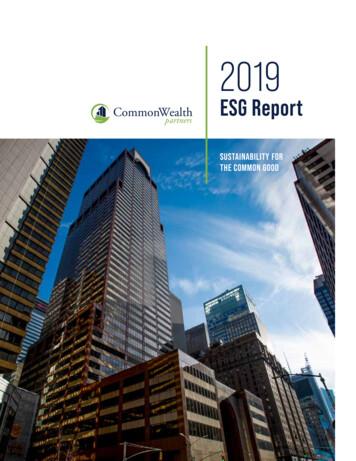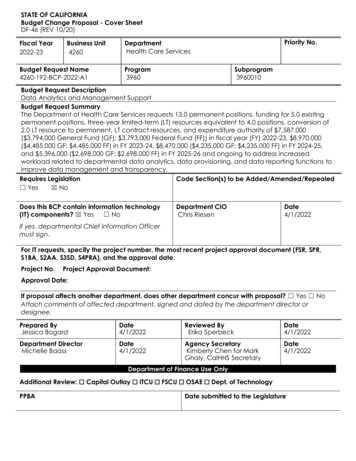
Transcription
STATE OF CALIFORNIABudget Change Proposal - Cover SheetDF-46 (REV 10/20)Fiscal Year2022-23Business Unit4260Budget Request Name4260-192-BCP-2022-A1Priority No.DepartmentHealth Care ServicesProgram3960Subprogram3960010Budget Request DescriptionData Analytics and Management SupportBudget Request SummaryThe Department of Health Care Services requests 13.0 permanent positions, funding for 5.0 existingpermanent positions, three-year limited-term (LT) resources equivalent to 4.0 positions, conversion of2.0 LT resource to permanent, LT contract resources, and expenditure authority of 7,587,000( 3,794,000 General Fund (GF); 3,793,000 Federal Fund (FF)) in fiscal year (FY) 2022-23, 8,970,000( 4,485,000 GF; 4,485,000 FF) in FY 2023-24, 8,470,000 ( 4,235,000 GF; 4,235,000 FF) in FY 2024-25,and 5,396,000 ( 2,698,000 GF; 2,698,000 FF) in FY 2025-26 and ongoing to address increasedworkload related to departmental data analytics, data provisioning, and data reporting functions toimprove data management and transparency.Requires LegislationCode Section(s) to be Added/Amended/Repealed Yes NoDoes this BCP contain information technology(IT) components? Yes NoDepartment CIOChris RiesenDate4/1/2022If yes, departmental Chief Information Officermust sign.For IT requests, specify the project number, the most recent project approval document (FSR, SPR,S1BA, S2AA, S3SD, S4PRA), and the approval date.Project No.Project Approval Document:Approval Date:If proposal affects another department, does other department concur with proposal? Yes NoAttach comments of affected department, signed and dated by the department director ordesignee.Prepared ByJessica BogardDate4/1/2022Reviewed ByErika SperbeckDate4/1/2022Department DirectorMichelle BaassDate4/1/2022Agency SecretaryKimberly Chen for MarkGhaly, CalHHS SecretaryDate4/1/2022Department of Finance Use OnlyAdditional Review: Capital Outlay ITCU FSCU OSAE Dept. of TechnologyPPBADate submitted to the Legislature
Analysis of ProblemA. Budget Request SummaryThe Department of Health Care Services (DHCS) requests 13.0 permanent positions, funding for5.0 existing permanent positions, three-year limited-term (LT) resources equivalent to 4.0positions, conversion of 2.0 LT resource to permanent, LT contract resources, and expenditureauthority of 7,587,000 ( 3,794,000 General Fund (GF); 3,793,000 Federal Fund (FF)) in fiscalyear (FY) 2022-23, 8,970,000 ( 4,485,000 GF; 4,485,000 FF) in FY 2023-24, 8,470,000 ( 4,235,000GF; 4,235,000 FF) in FY 2024-25, and 5,396,000 ( 2,698,000 GF; 2,698,000 FF) in FY 2025-26 andongoing to address increased workload related to departmental data analytic, dataprovisioning, and data reporting functions to improve data management and transparency.This workload is supported by Enterprise Data and Information Management (EDIM), which inclose coordination and collaboration with Enterprise Technology Services (ETS) and the Officeof Legal Services (OLS), and in partnership with DHCS programs supports robust data analytics,reporting, and management for DHCS.Position SummaryDivision- Positions effective 7/1/22EDIM Program Data Reporting Division (PDRD, or similar):2.0 Permanent Positions1.0 Career Executive Assignment (CEA B)1.0 Research Data Specialist III (RDS III) Convert 1.0 LT resource to Permanent1.0 Research Data Specialist II (RDS II)EDIM Data Management and Analytics Division (DMAD):5.0 Permanent Positions1.0 Research Data Supervisor I (RD Sup I)2.0 RDS II1.0 Research Scientist II (RS II)1.0 Research Scientist I (RS I)Permanent Funding Equivalent to 5.0 Positions1.0 Staff Services Manager I (SSM I)4.0 Associate Governmental Program Analyst (AGPA)EDIM Health Information Management Division (HIMD):3.0 Permanent Positions1.0 Information Technology Manager II (ITM II)1.0 Information Technology Supervisor II (ITS Sup II)1.0 Information Technology Specialist I (ITS I)Convert 1.0 LT resource to Permanent1.0 RDS IIExtending 4.0 LT resources for three-years4.0 RDS IActivitySupport data reporting needs ofongoing Medi-Cal managed careprogramsSupport data reporting needs ofdepartmental administrativefunctions and other programsthroughout the DepartmentPerform data transparency,coordination, data mining andadvanced statistical analyses andreporting. Conduct departmental data releaseactivities, including managing datarelease agreements.Support programmatic work throughoutthe Department Monitor data quality andmanagement support for softwareplatforms and other analytic toolsand resources.Manage data standards, exchange,and integrationConduct the data analysis, datavalidation, data issue resolution, anddata support functions for theplanning and design, development,and implementation phases of the274 expansion to MHPs and DMCODS, as well as to provide theongoing data quality monitoring and1
Analysis of ProblemDivision- Positions effective 7/1/22ETS Business Operation Technology Services Division(BOTSD)2.0 permanent positions1.0 Information Technology Manager I (ITM I)1.0 Information Technology Specialist II (ITS II)OLS Privacy Office (PO)1.0 permanent position1.0 Attorney IIIProduct/EffortTraining and staff development in dataanalyticsAnalytic coding curationSharePoint/Teams Architect andSharePoint/Teams DeveloperArchitecture and Infrastructure SupportReference Data ProcurementTotalActivityanalysis support to plans and DHCSstaff related to the resulting data.Perform data documentation,visualization, reporting, and analyticalsupport to DHCS programs.Provide expert legal advice to supportlegally compliant data use andprotection.Contract SummaryDuration2022-233-year LT 250,0003-year LT3-year LT3-year LTOngoing2023-24 500,0002024-25 250,000 125,000 125,000 250,000 250,000 125,000 125,000 1,000,000 2,000,000 3,500,000 2,000,000 2,000,000 5,000,000 2,000,000 2,000,000 4,500,000B. Background/HistoryDHCS is the single state agency responsible for administering California’s Medicaid program,known as Medi-Cal, which provides health care for nearly 14 million beneficiaries, nearly onethird of the state’s population and almost half of its children. Medi-Cal also disproportionatelycovers low-income and disadvantaged communities representing the lowest quartile of thestate Health Equity metric, as well as black and brown populations in the state of California,compared to other payers. As a result, driving improvements in quality in the Medi-Calprogram is a critical foundation for the state’s efforts to eliminate health care disparities. Dataanalytics and reporting are a core component of this quality improvement and play anessential role in the monitoring and oversight functions of DHCS for all of its programs.EDIM was established to consolidate data analytics, management, provisioning, and reportingin 2020. EDIM is responsible for a variety of data functions, such as program performance andoutcomes reporting, such as the Centers for Medicare & Medicaid Services (CMS) Core SetQuality Measures reporting; program utilization and monitoring including dashboards; dataquality monitoring and management; data releases and data provisioning to support variousresearch efforts external to DHCS; and data de-identification for public release of publications,reports, and products. In 2021-22, DHCS has further aligned data functions within EDIM in orderto improve data literacy and data-driven decision making which is necessary to supportbusiness programs and initiatives. This focus on data aligns with state and federal prioritiesrelated to data and transparency and expands EDIM‘s workload and scope of responsibility.EDIM is reorganizing further, from two divisions to three divisions. EDIM currently consists of theDeputy Director’s Office and the Data Management and Analytics Division (DMAD) andHealth Information Management Division (HIMD). Under the restructure, DHCS will create anew division, tentatively titled the Program Data Reporting Division (PDRD, or similar), utilizingredirected staff from within EDIM, redirected staff from other DHCS programs, and new 2022-23resources.2
Analysis of ProblemIn recent years, various changes in state and federal law, development of data provisionpolicies and processes, stakeholder requests, and increased focus on health disparities haveresulted in new expectations and workload for DHCS without corresponding increases inresources. DHCS is unable to keep pace with the workload, resulting in a backlog of reportsand data publications, data projects delayed or uninitiated, and other functions not beingperformed. DHCS submitted a proposal to address this workload in the Governor’s Budgetreleased in January 2020 (Data Transparency Workload - 4260-059-BCP-2020-GB). The proposalwas subsequently withdrawn in response to the COVID-19 pandemic.This proposal incorporates the request in the previous Data Transparency Workload proposaland is intended to address gaps in data analysis, reporting, and management that currentlyexist and will not be addressed by alignment of data functions in EDIM. Resources in thisproposal will support various departmental programs that have known gaps in data literacyand analytics, including administrative activities in the Department. Functional categories ofdata analytics and data management addressed in this proposal include:1. Data Transparency and Coordination2. Data Visualization, Reporting, and Analytical Support to DHCS Programs3. Data and Data Analytic ManagementConducting these functions requires close coordination and collaboration with ETS and OLS.Therefore as EDIM‘s workload increases so does that of ETS and OLS. ETS manages thedepartment-wide information technology (IT) including IT strategic direction, enterprisearchitecture, IT governance, portfolio and project management, IT application andinfrastructure operations, and modernization of DHCS’ Medi-Cal Enterprise System. BOTSD, theMedi-Cal Enterprise System Modernization Division (MESMD) and the Information SecurityOffice (ISO) reside within ETS and support critical infrastructure and systems necessary for EDIMto perform its functions. Similarly, OLS is an integral part of the reviews of data provisioning andtransparency processes, providing expert, legal consultation and guidance to EDIM staff tosupport the use and protection of sensitive data in legally compliant ways. As the volume ofdata requests and analytic and reporting activities has increased, so has the workload relatedto these efforts for ETS and OLS.1. Data Transparency and CoordinationEDIM oversees and coordinates data releases and publication in compliance with the HealthInsurance Portability and Accountability Act of 1996 (HIPAA) standard for public release ofdata. This requires review, analysis, and documentation of data proposed for release byindividuals “with appropriate knowledge of and experience with generally acceptedstatistical and scientific principles and methods for rendering information not individuallyidentifiable” [45 CFR Section 164.514(b)(1)].Data transparency efforts include the following HIPAA-compliant data releases outside DHCS,pursuant to 45 CFR Section 164.514.a) Public reporting and/or provision of de-identified aggregate data.The HIPAA standard for these types of releases is met using one of two methods:1. Safe Harbor Method: requires removal of 18 identifiers and assurance remainingdata cannot be used to identify an individual.3
Analysis of Problem2. Expert Determination Method: requires review, analysis, and documentation of dataproposed for release by individuals “with appropriate knowledge of and experiencewith generally accepted statistical and scientific principles and methods forrendering information not individually identifiable [45 CFR Section 164.514(b)(1)].”DHCS uses the Expert Determination Method, following the DHCS Data De-identificationGuidelines (DDG) version 2.0. The DHCS Chief Data Officer (CDO) and DMAD fulfill therequirements of performing the Expert Determination for public data release. All requestsfor release of public data is submitted to the CDO to review and determine that it is deidentified. Thus the DDG created new workload; and as the demand for public data hasincreased, the demand for de-identification reviews has also increased. DHCS has notreceived increased resources to support the workload. Some specific examples of publicreporting and aggregate data requests are: Public Records Act (PRA) requests, data to bepublished to the California Health and Human Services Agency (CalHHS), Open DataPortal (ODP), GeoHub, and various state and federal reports.The introduction of the ODP and GeoHub filled an important departmental need for adata publishing platform for aggregate data DHCS generates. The ODP was established in2014 and the GeoHub was later added for geographic data. ODP and GeoHub postinghas grown from 94 data sets in 2015 to more than 140 in 2022. Approximately 55 percent ofthese are updated quarterly or monthly and 41 percent are updated annually, with about4 percent not routinely updated. In addition to the data de-identification reviews of datasets for publication to the ODP and GeoHub, DHCS receives and responds to inquiriesrelated to these data through the Open Data Mailbox. Such requests have increasedsteadily and continue to increase.Workload MeasureCDO Requests processed/year.DHCS Open Data Mailbox requestprocessed/year.DHCS Open Data Datasetspublished per year.Cumulative count of Open Datadatasets that require 28140b) Confidential data releases provided under data sharing agreements.DHCS receives requests for confidential individual-level data for various research andanalytical purposes from various types of organizations, including other State departments,non-profit organizations, universities, and others. Requests from non-profit educationalinstitutions, universities, and other external organizations, are reviewed and processedthrough the DHCS Data and Research Committee (DRC). Requests from other statedepartments are generally processed through DHCS’ Business Use Case Proposal (BUCP)process, under overarching agency-level or state-level data agreements. In addition, othertypes of requests are processed through other types of data agreements (e.g. BusinessAssociate Agreements), based on the nature of the request and the entity requesting thedata. All of these requests require close collaboration between internal DHCS programareas, other state departments, and the DHCS PO. Once the agreements are executed,the data are released following the DHCS Data Release process.DHCS has seen a steady, continuing increase in the volume of requests for confidential4
Analysis of Problemdata. A substantial and continually growing workload related to confidential data requestsare those from other state departments, and the related development and managementof BUCPs. The Deputy Director of EDIM is the CDO and serves as the Data Coordinator forDHCS to support implementation of agency-level agreements and data exchangeagreements. While the intra- and inter-agency agreements have streamlined the datarequest processes for requestors, it has increased the volume of requests and relatedworkload.For confidential requests from non-profit educational institutions and universities, DHCSadministers the DRC to receive and process applications for research involving DHCS data.For applications that are approved, DHCS establishes a Data Use Agreement (DUA) withthe requesting entity. With the establishment of the DRC, requests and related workloadhave continually and steadily increased year to year. Each application must be assessed,prioritized, and analyzed to determine whether to recommend approval or denial to theDHCS Director. Workload associated with this is shown in the table below.Workload MeasureConfidential data sharing - Provisioning ofconfidential data (university researcher/DRCrequests).Confidential data sharing - Provisioning ofconfidential data (inter-Department/BUCPrequests).Confidential data sharing - Interdepartmentaldata linkage developed (initial linkage or adhoc).Confidential data sharing agreements executed- Business Use Case Proposals, Data UseAgreements, other data sharing, contracts /agreements developed.Confidential data sharing - number of datareleases (ad hoc, hospital, BUCP, 101515678910087111171187148There is also a significant workload associated with communicating with potentialrequestors prior to a proposal being submitted to the DRC, consisting of conference calls todiscuss data elements requested, methodological considerations, timelines, anddevelopment of the DUA. Once a proposal is approved, there is workload associated withpulling the data, managing the release of the data, and providing training and technicalassistance support to the data recipient.Workload MeasureDRC mailbox email 8CalHHS recently established the Center for Data Insights and Innovation (CDII), which willimplement data initiatives in CalHHS departments to realize improved health and socialservices outcomes, identify and target resources to underserved populations, increasedata literacy and use enterprise-wide, develop solutions and initiatives that are personcentered rather than program-centered, and drive decision-making based on dataanalytics. The establishment of CDII expanded the scope and types of data requests andreporting, particularly the types of entities that can request to include non-profit5
Analysis of Problemorganizations (as opposed to non-profit educational institutions) and others. This willsubstantially increase the volume of requests and data releases.DHCS uses non-DHCS, confidential data for health services analytics and population healthmanagement. EDIM coordinates and supports the use of these data and inter/intraagency data feeds to departments/staff approved to analyze these data. This includesmanaging the data access request process, establishing and maintaining meta-data,managing data storage and permissions, and developing and maintaining contractsrelated to data sharing.Workload related to external data feeds include setting up and maintaining the exchangeof DHCS and non-DHCS data for the purpose of data linkage and subsequent use of linkeddata. Each type of agreement requires developing, coordinating, processing, andmaintaining data sharing agreements; coordinating and tracking the release of the data;tracking data use; processing ad hoc and recurring data requests; compiling datasets;and establishing and maintaining ongoing secure file transfers.2. Data Visualization, Reporting, and Analytical Support to DHCS ProgramsDHCS’ reporting and analytic needs continue to increase and demand for user-friendly datadisplays and reports continues to grow. This requires both redesign of reports that have beenprovided by the department as well as additional new reports leveraging easy to use tools,which are easily accessible. This requires specialized software and data reporting andpublication tools. Examples include dashboards, infographics, and graphical user interfacesthat support a variety of displays, in ADA-compliant formats. There is also a growing need forsuch reports to support quality assessment and performance improvement efforts for the arrayof programs administered by DHCS.DHCS collects, manages, analyzes and reports data relating to its various programs, includingmore than 14 million Medi-Cal beneficiaries and the programs that support them. While DHCSdoes extensive reporting, there continues to be gaps in data reported and thecommunication of the data. For example, data on the Open Data Portal includes data aboutproviders, beneficiary characteristics, managed care plan enrollment, dental utilization, andmental health utilization. Other utilization in the Medi-Cal program is not currently reported. Fordata that is reported, DHCS is critiqued for insufficient data visualizations and user-friendlysummaries. Recognizing this gap, DHCS is proposing a multi-pronged approach. Establishment of the Program Data Reporting Division (or similar) which will provide focusedleadership and work to support programmatic reporting that has improved consistencyacross program areas, supports training and development for staff to incorporateimproved data communication, and to support programs and stakeholders with increaseddata reporting over time. Adding staffing in EDIM to support data analytic teams in EDIM and other parts of thedepartment in the development and reporting of visualizations that reflect programmaticactivities. Adding contract support to specifically address training for data literacy and datareporting for staff in EDIM and more broadly in DHCS.3. Data and Analytic ManagementWhile DHCS has been bringing together data teams within EDIM, DHCS still has over a dozendivisions with research data teams that provide analysis and reporting for specificprogrammatic areas. Currently, these teams perform analyses independently and do nothave clear mechanisms for sharing best practices, coding approaches, or results. Under the6
Analysis of Problemleadership of the CDO, EDIM supports the development of consistency among programs in thisdistributed analytic environment. For example, the DHCS Data Publishing Style Guide wasdeveloped by the Office of Communications and the CDO team to provide improvedconsistency for data presentation. Comparable work needs to be conducted related to dataanalytic processes and methods. In particular, DHCS has established enterprise SAS and GISenvironments; however, DHCS does not have resources designated to provide expertisenecessary to curate and maintain centralized libraries of data or code for these environments.The various files related to these environments are stored in various locations within DHCS,including numerous eSAS drives and network drives. There are 11 eSAS drives that weretransitioned to EDIM in 2020, each originally created for divisions that have been re-organized.These eSAS drives contain over 70,000 folders and over 500,000 files. In addition to eSAS, thereare also numerous files and tables stored in the Management Information System/DecisionSupport System (MIS/DSS). Each of these environments require different access permissions anduse different processes; these are individual-based permissions as opposed to being teams orgroups based. EDIM does not currently have capacity or resources to catalog and organizethe folders and files contained in these various locations as current staff are focused onperforming analytic requests. Resources are needed to develop and maintain enterpriseprogramming/coding standards and best practices within EDIM and DHCS to develop andmaintain code libraries with coding standards, common data pulls, data linkage, andmeasure specifications.DHCS uses data that originates with other organizations that are reference data that is criticalto inform data analytics performed with DHCS data. Examples include reference data that ispurchased under licenses, such as First Data Bank drug database, Optum Encoder Pro forphysician codes, etc. Other examples include data that may be coming from other partners,such as data coming from California Department of Public Health (CDPH), Department ofHealth Care Access and Information (HCAI), California Department of Corrections andRehabilitation, California Department of Social Services, Medicare, and other governmententities. Working with these various data sets often requires data linkage and understanding ofthe data included in those data sets. This is specialized knowledge that takes time to build.In addition to data analytic work, data management functions are necessary for data qualitythat supports accurate data analysis. Data management functions include support of dataintegration and data feeds and data design including data architecture and data modelingacross the diverse DHCS repositories and systems. Data design supports the identification,analysis and scoping of data requirements and translates them into data models and dataspecifications to meet business needs. It also helps with the development and tracking of dataassets used to support DHCS business processes and the applications that are automatingthose processes to enable traceability through various processes and identify data impacts.7
Analysis of ProblemResource History(Dollars in thousands)Data Management and Analytics DivisionProgram d ExpendituresN/AN/AN/AN/A 9,146Actual ExpendituresN/AN/AN/AN/A 9,146RevenuesN/AN/AN/AN/AN/AAuthorized PositionsN/AN/AN/AN/A51.0Filled Effective FY 2020-21 Information Management Division and Research & Analytic Studies Divisionhave reorganized into Enterprise Data and Information Management, Data Management andAnalytics Division and Health Information Management Division.Health Information Management DivisionProgram d ExpendituresN/AN/AN/AN/A 2,901Actual ExpendituresN/AN/AN/AN/A 2,829RevenuesN/AN/AN/AN/AN/AAuthorized PositionsN/AN/AN/AN/A32.5Filled Effective FY 2020-21 Information Management Division and Research & Analytic Studies Divisionhave reorganized into Enterprise Data and Information Management, Data Management andAnalytics Division and Health Information Management Division.Business Operations Technology Services Division* Enterprise Technology Services was reorganized during FY 2020-21, and three new divisions werecreated; (1) Business Operations Technology Services Division, (2) Information Technology StrategyServices Division and (3) Medi-Cal Enterprise System Modernization. At this time resource history tableinformation is not available for this division.8
Analysis of ProblemOffice of Legal ServicesProgram d Expenditures 16,969 18,243 19,872 21,573 21,951Actual Expenditures 16,750 18,243 19,872 21,573 19,686RevenuesN/AN/AN/AN/AN/AAuthorized Positions110.5112.0117.0125.0126.0Filled 4.615.911.0Workload HistoryNote: No workload history for the Program Data Reporting Division (or similar) is included as it will be anew division effective 2022-23. Workload for the division is currently performed under various DHCSprograms whose data staff are being consolidated under EDIM.Data Management and Analytics DivisionWorkload MeasureCDO Requests processed/year.DHCS Open Data Mailbox requestprocessed/year.DHCS Open Data Datasets published peryear.Cumulative count of Open Data datasetsthat require maintenance.DRC mailbox email countConfidential data sharing - Provisioning ofconfidential data (university researcher/DRCrequests).Confidential data sharing - Provisioning ofconfidential data (inter-Department/BUCPrequests).Confidential data sharing Interdepartmental data linkage developed(initial linkage or ad hoc).Confidential data sharing agreementsexecuted - Business Use Case Proposals,Data Use Agreements, other data sharing,contracts / agreements developed.*Confidential data sharing - number of datareleases (ad hoc, hospital, BUCP, 2678910087851111711871489
Analysis of Problem*This workload has been performed by DMAD through 2020-2021. Going forward, HIMD will performthis work as described in this proposalHealth Information Management DivisionWorkload MeasureBusiness Intelligence Dashboards andmodulesData Quality/Codes email box requestsDevelop and maintain SharePoint sitesand toolsMaintain statistical reports andpublicationsPerform HIPAA issue analysis includingformal complaintsAssist in Companion Guidesdevelopment and maintenanceAPD, Contracts and RFO developmentand 211224681624244050Enterprise Technology Services - Business Operations Technology Services DivisionWorkload Measure2016-172017-182018-192019-202020-21Data feeds into MIS/DSS.Completed change requests to resolvedata quality issues.User support requests for electronicStatistical Analysis System (eSAS) andArcGIS processed per year.Teradata Space Usage.Data storage and managementsolutions developed, implemented andsupported.Technical platforms and processes tosupport data built and maintained.Service requests completed within 5business days.IT procurements that support businesscritical applications, projects, 171710
Analysis of ProblemOffice of Legal Services – Privacy OfficeWorkload MeasureResearch federal and state laws,advise on legally compliantapproaches.Draft and negotiate contracts, businessassociate agreements, and data useagreements.Review and approve data releases.Review data requests from researchersfor compliance with State and federalprivacy laws, Committee for Protectionof Human Subjects jurisdiction andapproval, and DHCS policies andprocedures.Revise and maintain Privacy Policiesand Procedures to incorporateprogrammatic improvements andissues.Provide responses to public, legislative,and stakeholder inquiries.Meet with DHCS clients; representDHCS in CMS, Agency, and stakeholdermeetings; and consult with ChiefCounsel, Privacy Officer/ACC, andother OLS team 15010025120150175200200510510680700700C. State Level ConsiderationThis proposal directly supports the DHCS Strategic Plan commitment to maintain effective,open communication and engagement with the public, our partners, and other st
proposal will support various departmental programs that have known gaps in data literacy and analytics, including administrative activities in the Department. Functional categories of data analytics and data management addressed in this proposal include: 1. Data Transparency and Coordination 2.
